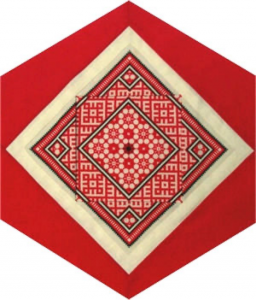Belarus

The Block
Childhood friends Ludovika Bucka-Bielenis and Raisa Zuk-Hryskievic collaborated on this block which features an example of the complex cross-stitch designs for which the country is so well-known. Belarusian embroidery used to decorate the shirts and blouses of the national and regional dress is distinctive. The repetitive geometric pattern is worked in red thread with black used for emphasis and outlines. The background fabric is white, homespun linen, a fitting selection because Belarus is renowned for its flax. Embroidery is traditionally done in three colours and each has a specific meaning: white is the colour of heaven, red represents the sun and earth and is protective of organic life, and black symbolizes the underworld and spiritual life.
Cultural Profile
Belarus, formerly Byelorussia, is a landlocked republic in east-central Europe that has long been known as a centre of advanced science and engineering. The country has a complex history and various parts of its territory were successively part of Lithuania, the Russian Empire, Poland and Soviet Russia. Ethnic Belarusians make up more than three-quarters of the population, with Russians the next largest group followed by Poles and Ukrainians. There are two official languages: Russian and Belarusian. Although Russian is more widely spoken, Belarusian is central to the concept of national identity and seen by many as essential to Belarusian culture. At the fall of the Soviet Union in 1991, Belarus declared its independence, but close economic and political ties remain between the country and present-day Russia.
Storytelling is an integral part of this culture and includes kaski (fairy tales), which are told to children to teach them moral values. Sports are taken very seriously, as evidenced in the 482 schools throughout the country that provide intensive training.
There is also a strong tradition of folk and religious music, the former dating back to the 15th century. Religious music, rooted in the Orthodox Church, also has a long history and has gradually changed through the centuries as it has been influenced by events in the rest of Europe. Partesnoe penie, part singing, which became common for choruses in the 17th century, still enthralls audiences around the world. Belarus’ opera and ballet companies have long-standing reputations as well. Today, pop and rock music are also establishing a strong presence in Belarusian culture.
Belarusians are also known in other artistic fields. The work of artist Marc Chagall and writer Natalia Arseneva (author of Beneath the Blue Sky), have had an international impact. Artisans produce woodcarvings of figures with painted faces, brightly coloured ceramic ornaments and flax and straw figurines. Textiles arts include rushnyk embroidery such as the piece on the block. Mostly done with red and white, this type of embroidery is a strong Belarussian symbol, displaying specific geometric patterns for each region. Learning to stitch a rushnyk was once part of a girls’ upbringing and each household proudly displayed these pieces alongside religious icons; they also played an important part in wedding and funeral traditions. Slutsk belts were also made in Belarus and today are a prized possession. Woven by men with silk, gold and silver threads, these belts could reach 4 metres in length and were worn by the nobility. Today, very few belts remain as the techniques involved in their making were lost, but the country is working to revive this tradition.
Belarusians began arriving in Canada in the early 1900s, although the first immigration listing as an individual country was not until 1992. The 2011 census recorded just over 8,000 Belarusians living in Canada. Many early settlers who went to Ontario, Québec, Manitoba and Saskatchewan were farmers, while a large number of people who came after WWII became factory, lumber and construction workers. Today many Belarusians coming to Canada are highly educated and skilled individuals who contribute to society in a variety of areas.
Sponsor: Belarusian Canadian Co-ordinating Committee
